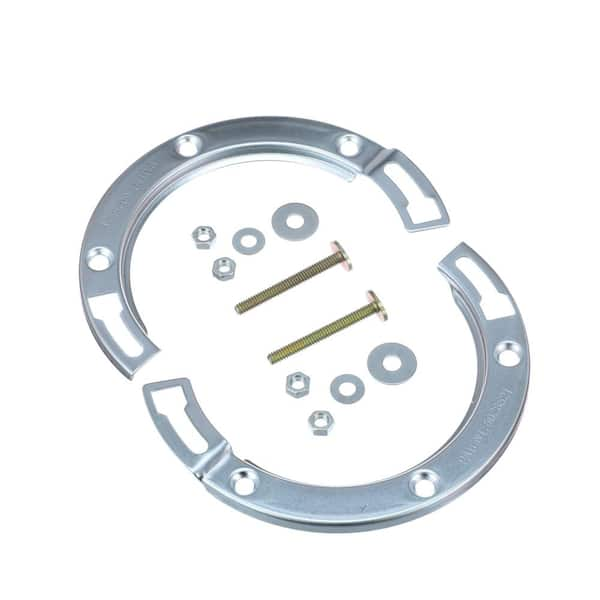Almost everyone seems to have his or her own thinking about How to Replace a Toilet Flange.

Introduction:
Recognizing the Importance of a Toilet Flange:
In the realm of plumbing, the often-overlooked commode flange plays an essential duty in ensuring the smooth operation of your restroom fixtures. As a vital connector between your toilet and the underlying waste pipe, the commode flange functions as the unrecognized hero of your plumbing system. Without this tough element, your bathroom would certainly be prone to instability and leakages, potentially causing expensive repair services and aggravation. Consequently, understanding the value of a correctly set up and maintained bathroom flange is extremely important for any property owner embarking on plumbing jobs or attending to repair requirements.
Why Proper Installation and Maintenance Matter:
Correct installment and meticulous upkeep of the toilet flange are crucial for protecting the honesty of your plumbing framework. A diligently set up flange not only supports your commode firmly in place yet also creates a bulletproof seal, warding off the perils of leakages and odours. By accepting an aggressive approach to flange maintenance, you can reduce the risk of disruptive plumbing concerns and protect the serenity of your house atmosphere. Throughout this informative overview, we'll decipher the intricacies of commode flange installment and repair, encouraging you with the knowledge and know-how to navigate these important tasks expertly.
Finest Practices When Installing a Toilet Flange:
Making sure a seamless commode flange setup requires adherence to a set of finest practices that ensure resilience and functionality. Begin by meticulously examining your devices and materials, ensuring you have the essential equipment for the task in advance. Picking the suitable flange product, whether PVC, ABS, or cast iron, is vital, as it establishes the durability and efficiency of your plumbing fixture. In addition, assessing existing plumbing problems, such as looking for damage or rust, is necessary for preemptively addressing prospective complications and guaranteeing a smooth installation process. By taking on these preparatory measures, you set a solid structure for an effective toilet flange installation, reducing the probability of future issues and promoting lasting maintenance.
As soon as adequately ready, proceed with the mindful elimination of the old flange, complying with a systematic approach to prevent triggering damages to bordering elements. Use methods tailored to address persistent or rusted flanges, ensuring their swift and risk-free elimination without compromising the stability of the bordering plumbing framework. With the old flange got rid of, thoroughly install the new replacement flange, choosing one that fits snugly and safely into area. Correctly protecting the flange to the flooring making use of screws or adhesive is vital, as it makes sure security and stops future leakages. By adhering to these ideal methods throughout the setup procedure, you lay the groundwork for a durable and trustworthy toilet flange configuration that withstands the examination of time.
Setting Up a New Toilet Flange:
When mounting a brand-new bathroom flange, the initial step is to pick the best substitute for your plumbing setup. Take into consideration factors such as the material of the flange, with choices consisting of PVC, ABS, or cast iron. PVC flanges are known for their cost and resistance to rust, making them a prominent choice for DIY fanatics. ABS flanges supply similar advantages to PVC yet brag included toughness, making them suitable for high-traffic locations or business setups. Cast iron flanges, renowned for their toughness and long life, are ideal for setups where resilience is extremely important. Furthermore, make certain that the replacement flange is effectively sized and fits comfortably into area to create a leak-proof seal and stop leaks.
Protecting the Flange to the Floor:
When you've chosen the best substitute flange, it's critical to secure it properly to the floor to make certain stability and avoid future problems. Begin by placing and lining up the flange correctly over the waste pipe, ensuring that it sits flush with the floor surface area. Depending on the kind of flange and your particular installation choices, you can protect the flange to the flooring making use of screws or sticky. If making use of screws, make sure to utilize corrosion-resistant alternatives to avoid rusting with time. Alternatively, adhesive can offer a safe and secure bond between the flange and the flooring, ensuring a strong and reputable installment. By adhering to these actions and taking the necessary safety measures, you can mount a new bathroom flange with self-confidence, ensuring a lasting and leak-free plumbing component.
Best Practices When Repairing a Broken Flange:
Repairing a busted toilet flange needs precise interest to detail and adherence to best practices to make certain a lasting remedy. Begin by thoroughly evaluating the degree of the damage and identifying the underlying reason, whether it be deterioration, cracks, or misalignment. This assessment will direct your repair method, enabling you to choose the most suitable strategies and products for recovering the flange to its ideal condition. Furthermore, take into consideration the bordering plumbing infrastructure and flooring stability to address any possible contributing elements and avoid future issues from developing. By carrying out an extensive evaluation and evaluation, you lay the groundwork for a reliable and enduring repair procedure that deals with the source of the problem.
With a clear understanding of the flange's condition and the variables influencing its damages, proceed with the repair service procedure using precision and care. Relying on the seriousness of the damage, you may choose repair methods such as epoxy putty, repair flange packages, or partial flange replacements. Make sure that the selected fixing approach effectively deals with the specific concerns handy while keeping the architectural honesty and capability of the flange. In addition, take proactive procedures to strengthen the fixed flange and avoid future damage, such as applying sealant or waterproofing materials to secure against leaks and rust. By adhering to these finest practices during the repair procedure, you can restore your busted flange to ideal condition, making sure the long-lasting reliability and efficiency of your plumbing system.
Kinds Of Toilet Flanges:
Recognizing the numerous kinds of bathroom flanges is crucial for choosing one of the most appropriate choice for your plumbing needs. PVC, ABS, and cast iron are amongst the usual products used in commode flange construction, each offering distinctive benefits and factors to consider. PVC flanges, recognized for their price and corrosion resistance, are favoured for their ease of installation and toughness. Abdominal flanges, similar to PVC in terms of price and simplicity of installment, are valued for their robustness and resistance to influences. On the other hand, cast iron flanges, renowned for their phenomenal toughness and durability, are typically favored for high-traffic areas or business settings where sturdiness is vital. By familiarising on your own with the qualities of each product, you can make a notified choice when selecting a bathroom flange that straightens with your certain requirements and choices.
In addition to product factors to consider, toilet flanges likewise can be found in various design and styles to accommodate various plumbing setups and installation choices. Offset flanges, for instance, are made to suit bathrooms installed on floors that are not level or where the drain lies off-centre. Similarly, repair service flanges, also referred to as repair service rings or spacer rings, are used to deal with issues such as cracked or broken flanges without the demand for considerable plumbing modifications. In addition, adjustable flanges provide flexibility ready, enabling accurate placement and fit during setup. By checking out the varied series of commode flange kinds and layouts offered, you can select the alternative that finest suits your plumbing setup and installation requirements, guaranteeing a smooth and trustworthy option for your washroom components.
Specialty Options:
In addition to traditional commode flanges, there are specialized choices available to attend to specific plumbing challenges and installment preferences. One such alternative is the offset flange, which is designed to accommodate bathrooms mounted on floors that are uneven or where the drain lies off-centre. Offset flanges include a distinct style that allows the toilet to be placed at a minor angle, compensating for unequal flooring or misaligned plumbing links. This innovative solution makes sure a protected and steady installment, eliminating the requirement for costly and taxing floor progressing or pipeline moving. By integrating an offset flange into your plumbing setup, you can get rid of common installment obstacles and accomplish a professional-quality outcome with ease.
Another specialty alternative worth thinking about is the repair service flange, additionally referred to as a repair service ring or spacer ring. Repair flanges are specifically designed to resolve concerns such as split or damaged bathroom flanges without the need for extensive plumbing alterations. These flexible components can be mounted directly over the existing flange, giving a durable and dependable base for safeguarding the toilet in position. Repair flanges come in different dimensions and configurations to fit different flange sizes and installment demands, making them a practical and economical solution for solving flange-related issues. Whether you're managing a small flange repair service or a more complicated plumbing problem, incorporating specialized alternatives like offset and repair service flanges can enhance the setup process and make sure durable performance for your shower room fixtures.
Conclusion:
Finally, grasping the art of bathroom flange installation and fixing is vital for preserving a practical and leak-free plumbing system in your house. By comprehending the significance of an appropriately installed flange and sticking to best techniques throughout the process, you can ensure the durability and reliability of your bathroom components. Whether you're choosing the right kind of flange, performing fixings, or exploring specialty choices, interest to detail and thorough execution are crucial. Normal upkeep and proactive troubleshooting can help stop costly plumbing problems and protect the peace of your home setting. Equipped with the knowledge and abilities obtained from this extensive overview, you can take on commode flange installment and repair service with self-confidence, equipping you to guard your plumbing system for several years ahead.
How to Replace a Toilet Flange That’s Old or Broken
Turn Off the Water Supply
As with many other plumbing tasks, the first step is to turn off the water supply to the toilet so you don’t end up dealing with a messy leak. Look for the shut-off valve on the wall behind the toilet—typically located closer to the floor—and turn it all the way clockwise.
Empty the Toilet Bowl and Tank
Now, it’s time to drain the water remaining in the bowl and tank and confirm that the supply line is fully closed. Flush the toilet a few times until the bowl no longer fills with water. You can use a plunger to drain any small volume of water lingering at the bottom of the basin. If the tank continues to replenish the bowl after a few tries, you need to go back to step one and keep turning the knob on the water supply until it’s all the way off.
Disconnect the Water Supply
Set down towels or a tarp on the bathroom floor to keep it safe from the moderate water runoff that can happen while disassembling a toilet. Look for a hose, usually made of braided metal, that runs from the tank to the joint with the shutoff valve.
Loosen it at the end attached to the fill valve on the underside of the toilet. If you have trouble doing so by hand, try using an adjustable wrench. Expect a bit of water leakage when the hose disconnects.
Remove the Toilet Tank
Look for the two or three mounting bolts on the bottom of the tank that connect it to the bowl on each side. Using your wrench, loosen the nuts from the bolts and set them somewhere safe and accessible. Carefully lift the tank up and off the bowl and set it aside. Take some time to review the parts of a toilet as you get ready for the next step.
Remove the Toilet Bowl
Now comes the hardest part. Be prepared to lift the toilet bowl—typically weighing between 70 and 120 pounds—off the ground. If you’re not confident you can safely lift and remove a toilet, you’ll need a helper on hand to help shoulder the weight.
The first step is to remove the caps from the bolts that secure the toilet's base to the floor. In most cases, there will be two of them on each side of the bowl. Use a screwdriver to pry off the caps, and then use the wrench to loosen and remove the nuts from the bolts. Set them aside for later.
Once you have removed the nuts, grab each side of the commode and gently rock it back and forth until it’s loose and the seal of the wax ring beneath the base breaks.
The bowl is now ready to lift. Straddle the toilet and crouch, reaching down until you have a grip on the underside of the bowl. Stand steadily and slowly, lifting with your legs, until the bowl is off the bolts. Set it down on its side on top of your tarp.
Unscrew the Mounting Bolts
Most likely, you’ll find that the flange mounts to the floor with four screws. Insert your screwdriver and turn each screw counterclockwise until it’s loose enough to remove. If the hardware is in good shape, you can set the pieces aside to reuse with your new flange.
Lift the Flange to Remove
The flange is a circular fitting (2 to 3 inches in diameter) that sits underneath the toilet; it connects the internal drainage system to the drainpipe while securing the base of the toilet to the floor. Most toilets feature a PVC flange sealed with a gasket. If yours does, with the wax ring scraped away and the bolts loose, you can simply lift it up from the drainpipe and set it aside.
Toilet flanges do, however, come in various materials and can feature different fitting types. If you reach this stage and it turns out you have a metal flange glued in place or attached with a deep-seal fitting, you’ll need to stop and hire a plumber to take care of the rest of the job.
Otherwise, you can risk damaging the drainpipe—a significantly more expensive and complicated problem to address.
Before moving on to the next step, take the opportunity to examine the subfloor around your toilet. If any patches are soft or spongy, you should call a pro to quote the price to replace the damaged subflooring before proceeding further.
Measure the Outflow Pipe
Before installing a toilet flange, you’ll need to make sure you’ve got the right size. One option is to bring the old flange to the hardware store to find a match. Otherwise, you’ll want to take some measurements.
Before jumping into how to change a toilet flange, use the measuring tape to determine the diameter of the old flange, double-checking to confirm you’ve done it right. Make sure to buy a flange that matches the size, shape, and material of the old one—as well as a new wax ring if there isn’t one in your new flange kit.
Fit and Install the New Toilet Flange
Once you’ve got an appropriately-sized new flange, it’s time to start setting the new toilet flange. Remove and throw away the rags or towel from the outflow pipe.
Fit the new flange snugly into the outflow pipe, creating a seal with the gasket and resting the outer lip flush to the floor. Using the included hardware, secure the flange to the subfloor with screws and slide on the toilet flange bolts. Remember to tighten the washers or nuts fully.
Add the New Wax Ring
There are two different ways to install the new wax ring: Securing it either to the flange or to the toilet base. The latter is the preferred option among pros and the better choice if you have the space and muscle to do so. With the commode lying on its side on the floor or tilting it upward, attach the replacement wax ring directly to the hole at the bottom and ensure it’s fitted correctly.
If attaching it to the toilet seems too tricky, you can simply place the wax ring on the flange, centering it around the hole.
Replace the Toilet Completely
With the replacement flange in place, all you need to do is reassemble the toilet. Lift the toilet from the floor—making sure to engage your leg muscles to avoid straining your back—and place it on top of the new flange. Be sure to line up the holes at the base with the flange bolts. Once it’s resting evenly, apply steady downward pressure from the top of the bowl to seal the wax. Be careful not to rock or wobble it so that you don’t break the seal.
With the hardware you set aside, secure each of the bolts on the bowl with the nuts and washers—turn them tightly enough to prevent the toilet bowl from wobbling but be careful not to over-tighten them and risk cracking the porcelain. Then replace the bolt caps.
Next, lift the tank and place it back on the bowl, aligning the bolts with the holes. With the nuts you set aside, tighten the bolts until the bowl and tank are evenly and securely aligned. Reattach the supply hose to the toilet tank. Slowly turn the valve to gradually open it, testing for leaks as water begins to flow back into the toilet. Once the tank has filled, flush the toilet and keep an eye on the base, making sure there’s no leakage at the base of the toilet.
https://www.angi.com/articles/how-to-replace-toilet-flange.htm

I'm very enthusiastic about How To Install a New Toilet Flange and I'm hoping you liked the new blog posting. Sharing is caring. Helping others is fun. I thank you for your readership.
Contact Us Now
 Mr. T Then & Now!
Mr. T Then & Now! Bradley Pierce Then & Now!
Bradley Pierce Then & Now! Romeo Miller Then & Now!
Romeo Miller Then & Now! Jenna Jameson Then & Now!
Jenna Jameson Then & Now! Freddie Prinze Jr. Then & Now!
Freddie Prinze Jr. Then & Now!